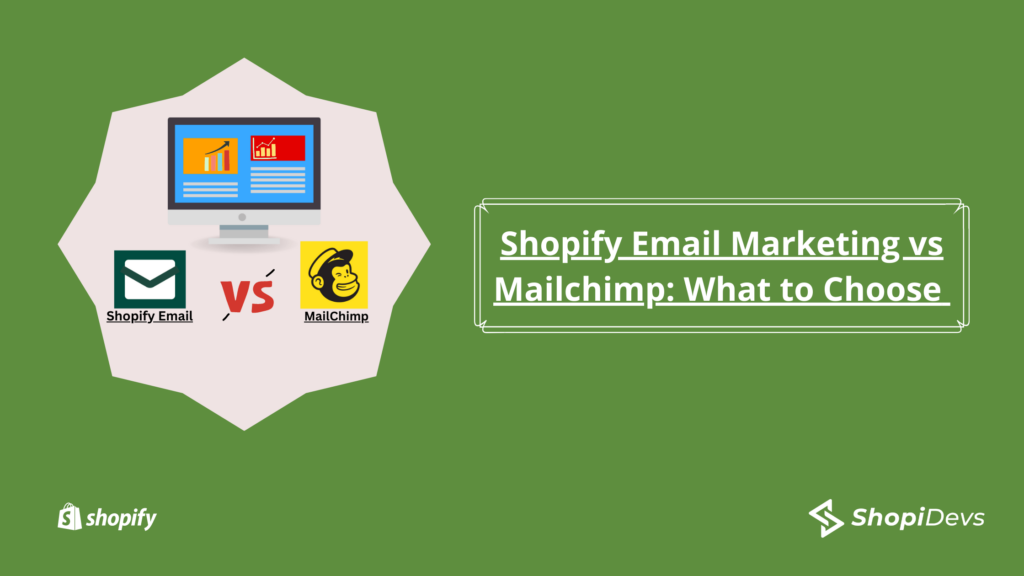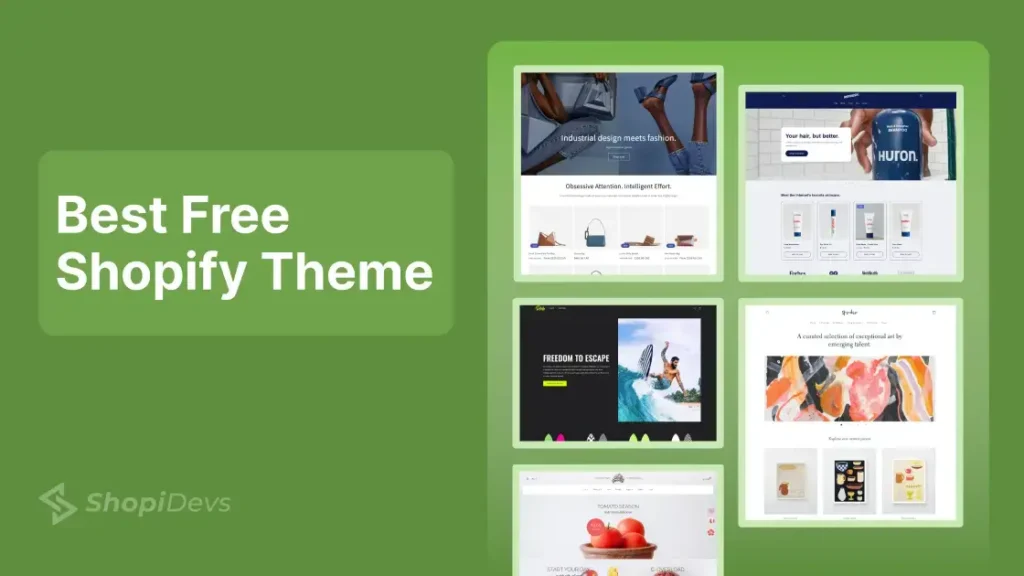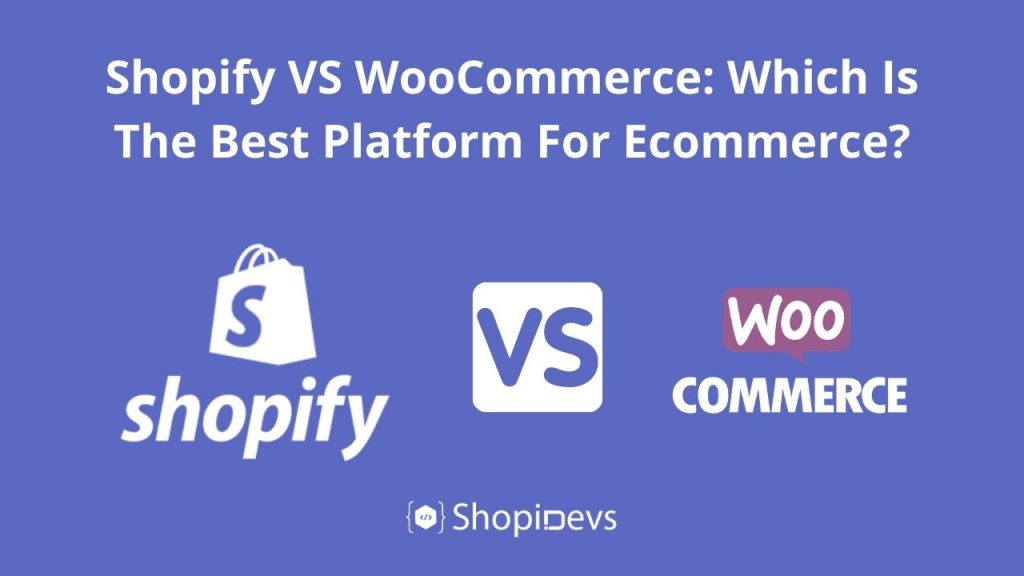When it comes to email marketing for your Shopify store, choosing the right platform can make a big difference in your business’s success.
Shopify Email Marketing vs Mailchimp are two popular options, each offering unique features to help you connect with your audience and drive conversions. With Shopify Email Marketing, users can easily create campaigns with built-in tools, while Mailchimp offers sophisticated segmentation and automation.
In this article, we’ll compare both platforms side by side, exploring their pros, cons, advanced features like email builders, targeting, automation, analytics, pricing, and more.
Keep reading to discover which one is right for your email marketing strategy!
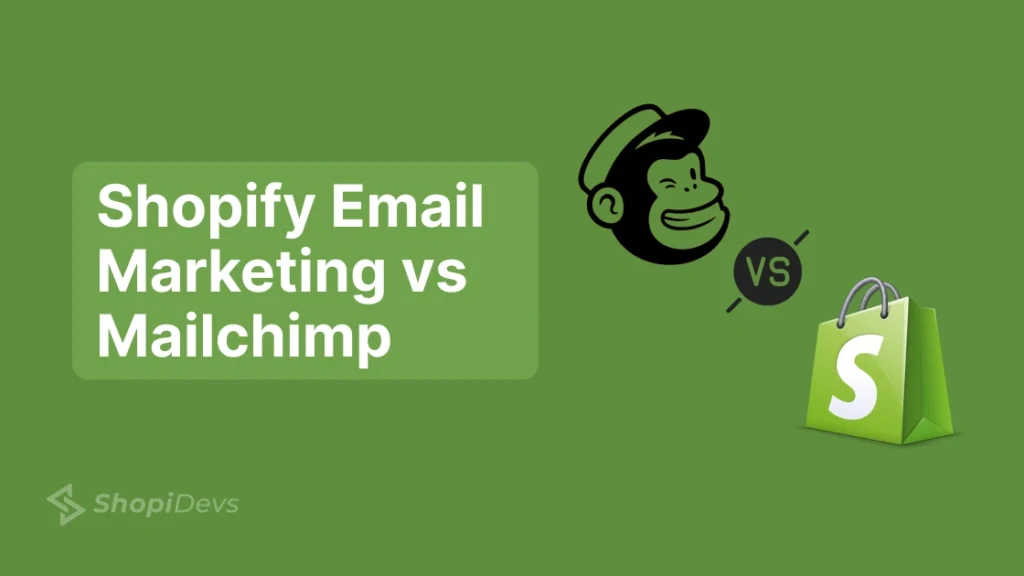
Shopify Email Marketing
Shopify Email is Shopify’s built-in email marketing tool designed for store owners. It offers a simple, beginner-friendly interface, seamless integration with customer data, and essential features like pre-made templates, basic automation, and customer segmentation. It’s ideal for Shopify users who want to run campaigns without third-party tools.
Pros
- Native integration with Shopify — no extra setup needed
- User-friendly interface with drag-and-drop builder
- Free to start with up to 10,000 emails per month
- Access to customer data for easy segmentation
Cons
- Limited email templates and design flexibility
- Basic automation features compared to other tools
- No SMS or social media marketing options
- Limited analytics and A/B testing capabilities
Mailchimp
Mailchimp is a powerful, all-in-one marketing platform known for its advanced automation, detailed segmentation, and multichannel support. It supports email, SMS, social media, and ads, making it a versatile choice for scaling businesses. Although not native to Shopify, it can be integrated through connectors for broader marketing capabilities.
Pros
- Advanced automation and segmentation tools
- A wide range of professional templates
- Multichannel marketing: email, SMS, social, ads
- In-depth analytics and A/B testing
Cons
- More complex interface, steeper learning curve
- Limited free plan with fewer features
- Integration with Shopify requires a third-party connector
- Costs can add up quickly for growing lists
Shopify Email Marketing vs Mailchimp: Comparison Table
Here is a comparison table for Shopify Email Marketing vs Mailchimp:
| Features | Mailchimp | Shopify Email Marketing |
| 1. Email Builders & Templates | Easy and intuitive editor with a wide range of prebuilt templates | Easy-to-use editor with essential templates |
| 2. List Building Features | Landing page builder and built-in form builder | No native builder, but supports the free Shopify Forms app |
| 3. Segmentation and Targeting | Advanced segmentation based on behavior, demographics, and engagement | Basic Shopify customer data filters (tags, orders, location, language, etc.) |
| 4. Email Marketing Automation | 70+ prebuilt workflows with advanced customer journey builder | Essential ecommerce automations (e.g., abandoned cart, welcome, upsell) + custom manual workflows |
| 5. Contact Management & Segmentation | Dedicated contact profiles with tags, segments, audience insights | Managed via Shopify’s customer panel with built-in filters |
| 6. Advanced Email Marketing Features | Predictive analytics, SMS, push notifications, social posts, comparative reporting | Core email tools only; lacks multichannel and predictive capabilities |
| 7. User Experience | Intuitive but more advanced — suited for experienced marketers | Beginner-friendly, quick setup, seamless Shopify integration |
| 8. Analytics and Reporting | Detailed campaign reports, A/B testing, and benchmarking | Campaign metrics, order tracking, funnel behavior insights |
| 9. Pricing | Free Plan: Up to 500 contacts / 1,000 monthly emails Essentials: From $13/month Standard: From $20/month Premium: From $350/month for 10,000 contacts. Check updated pricing. | Free: First 10,000 emails/month Additional: $1 per 1,000 (up to 300K), $0.65 (300K–750K), $0.55 (750K+). Check updated pricing. |
| 10. User Review | Praised for its powerful automation, multichannel tools, and segmentation flexibility | Praised for simplicity, ease of use, and seamless integration with Shopify |
1. Email Builders & Templates
Shopify Email and Mailchimp both offer user-friendly and intuitive email builders. Shopify Email is built as a plugin for the Shopify platform. It’s simpler with a fast and smooth setup process. This simplicity makes Shopify Email easy to use.
But Shopify Email falls short of the advanced capabilities found in Mailchimp. Mailchimp operates as a standalone marketing tool. It features a broader set of tools for marketers. It offers deeper personalization features, like dynamic product recommendations. You may need some time to fully explore its advanced functionality.
Let’s break down how their email builders compare feature by feature:
Content Blocks
Both platforms offer drag-and-drop email builders with modern, responsive designs. Shopify Email has key content blocks made for e-commerce. These include products, discounts, and gift cards. Mailchimp takes it a step further. It offers advanced blocks such as videos, surveys, and product reviews. It also gives product recommendations based on your cart, viewed items, or best sellers. Shopify Email lacks these dynamic features unless paired with third-party apps.
Email Templates
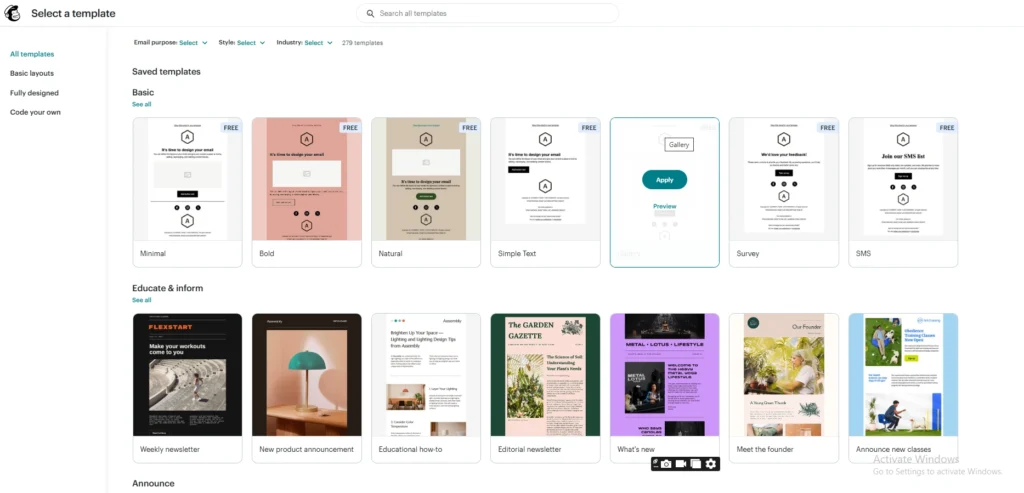
Mailchimp provides 279 basic templates, but only 7 are available on the free plan. Shopify Email has 46 branded templates. They automatically use your store’s logo, colors, and fonts. There’s no setup required. Both platforms support custom HTML templates and mobile-responsive designs.
Shopify has built-in branding and free AI drafting tools. These features help beginners a lot. But, Mailchimp’s Creative Assistant provides more flexibility. Yet, it only works with paid plans and might have some minor bugs.
2. List Building Features
Shopify Email doesn’t come with built-in list-building tools. You can use the free Shopify Forms app. You can also connect third-party apps to create popups, inline forms, and landing pages. The Shopify Forms app lets you easily create and launch signup forms. You can choose when and where they show up with custom triggers.
That said, Shopify Forms is fairly limited. It only supports basic email capture forms. For advanced features like multi-step forms, quizzes, or branded landing pages, you’ll need third-party integrations. This adds extra steps and may not be ideal for all users.
Mailchimp offers a much more robust set of built-in list-building tools. It includes a form builder, a landing page creator, and many pre-made templates for different campaign goals. You can even build landing pages on the go using Mailchimp’s mobile app.
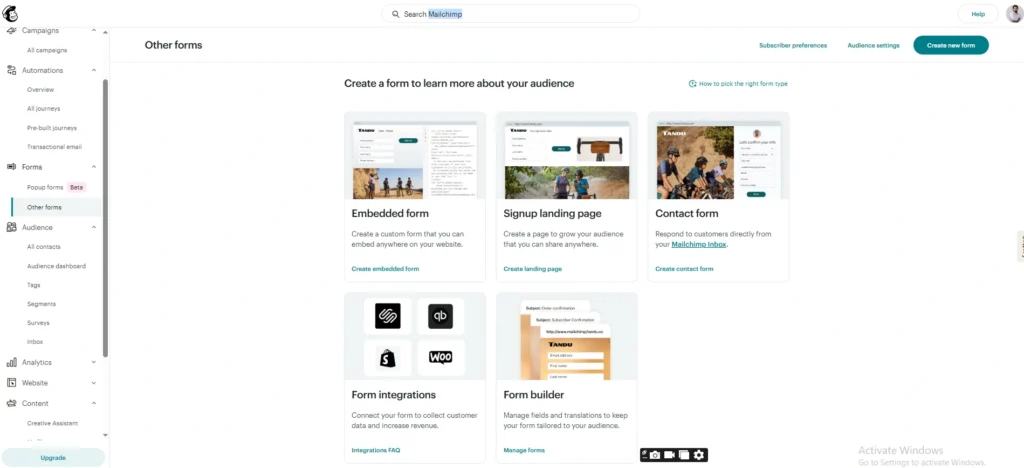
One standout feature is Mailchimp’s performance analytics for landing pages. This helps you track metrics such as conversion rate and engagement. So, you can find and improve pages that are not performing well. Mailchimp offers you better control and flexibility for growing your email list.
3. Segmentation and Targeting
Shopify Email offers strong segmentation options—especially for Shopify users. One big advantage is the ability to directly use your Shopify customer segments, making it faster and easier to create targeted email campaigns.

You can filter customers based on a variety of data points, including:
- Amount spent
- Location
- Customer account status
- Customer added date
- Customer email domain
- Language
- Customer tags
- Email events
- Email or SMS subscription status
- Last order date
- Number of orders
- Predicted spend tier
- Products purchased
All of these options are available under the Customers tab in your Shopify dashboard.
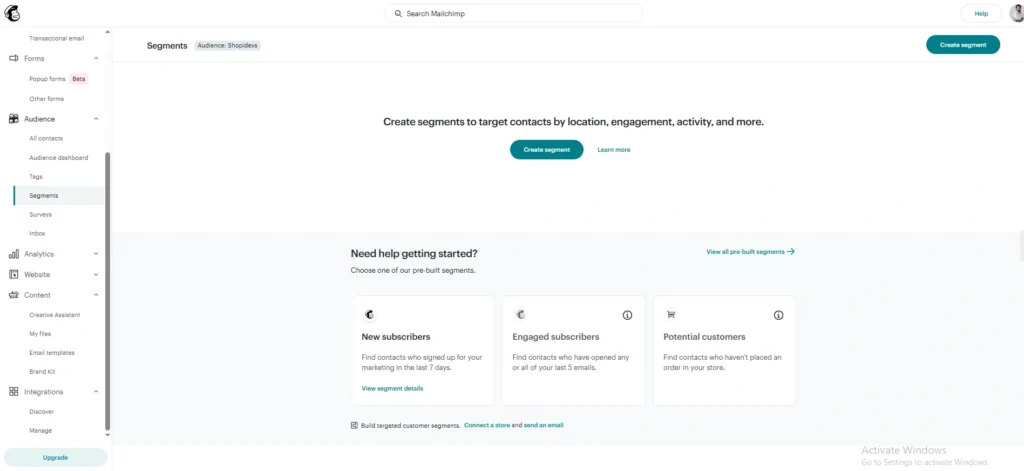
On the other hand, Mailchimp provides a more advanced and flexible segmentation system. You can create segments based on:
- Demographics
- Signup source
- Email and SMS engagement
- E-commerce activity
- Likelihood of repeat purchase
- Website behavior and engagement
What sets Mailchimp apart is its ability to combine up to 5 conditions per segment, using “AND” / “OR” logic. This allows for more complex and precise audience targeting.
4. Email Marketing Automation
Email automation can be simple, like sending an abandoned cart email. It can also be complex, with multi-step workflows and custom triggers. If you’re looking for basic automation, both Shopify Email and Mailchimp will do the job. But when it comes to advanced automation, Mailchimp clearly leads.
Shopify Email Marketing
Shopify Email provides a set of essential automation templates. It has 9 built-in automation templates. These templates cover common e-commerce situations and are great for basic email workflows. Also, you can use it to re-engage customers and boost conversions.

Shopify Email includes abandoned checkouts, first-purchase upsells, and post-purchase follow-ups. To create custom automation workflows, you need Shopify Flow. It’s part of all Shopify paid plans. It lets you create unique workflows by setting triggers, conditions, and filters. This helps make your marketing more personalized.
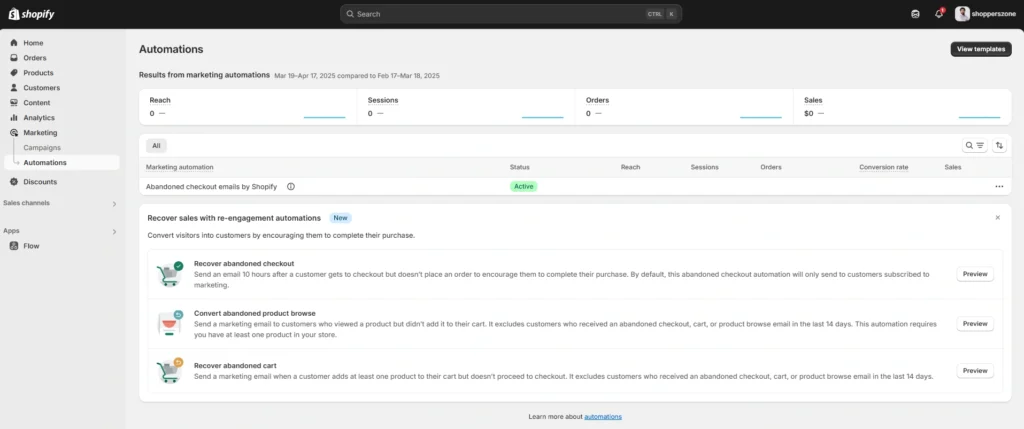
Here’s a list of some key automation options available in Shopify Email:
| Automation | Description |
| Abandoned Cart | Sends an email to customers who add products to their cart but don’t start the checkout process. |
| Abandoned Checkout | Sends an email to customers who begin checkout but don’t complete their order. |
| Abandoned Product Browse | Sends an email to customers who viewed a specific product but didn’t add it to their cart. |
| Custom | Allows you to design personalized email automations based on events you select. |
| Customer Winback | Sends an email to customers after a set amount of time following their last order. |
| First Purchase Upsell | Sends an email encouraging a purchase after a customer makes their first order. |
| Post-purchase Thank You | Sends a thank-you email after a customer’s first or second purchase. |
| Post-purchase Upsell | Sends an upsell email after a customer completes a purchase. |
| Welcome Email | Sends a welcome series (usually three emails) to new customers, sharing your brand story and social links. |
Mailchimp
Mailchimp, in contrast, provides powerful built-in marketing automation features. It offers 42 pre-built automation journeys that work seamlessly with Shopify. These include customer win-back flows, product retargeting, birthday emails, and more.
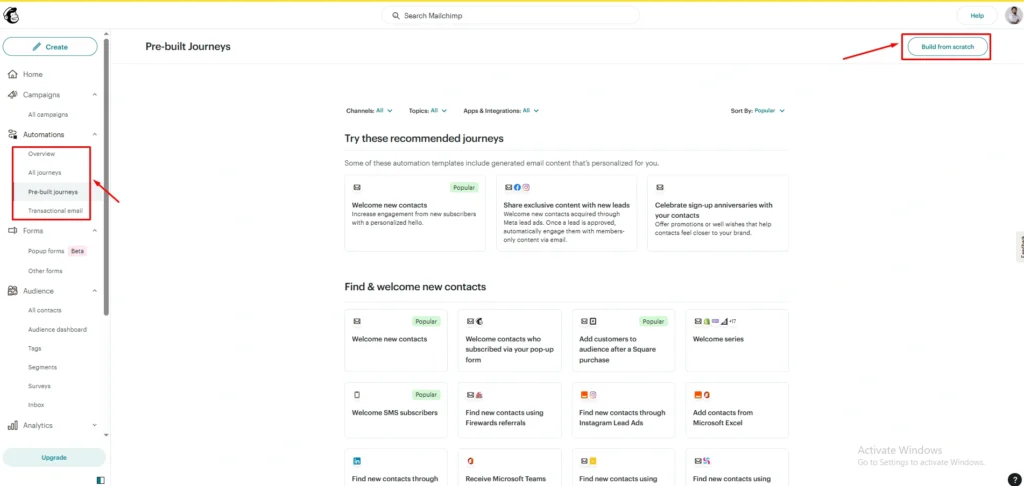
Besides, its Customer Journey Builder includes more than 70 ready-made templates. You can customize these with minimal effort, which gives it a big edge over Shopify Email. The journey builder is easy to use and great for beginners. It uses clear terms like “VIP customer” and “average spend per order.” You can set triggers and conditions, then send automated emails with little effort.
But all automation features of Mailchimp are only available on paid plans. It also limits the number of journey points depending on your plan. The Essentials plan has 4 journey points. In contrast, the Standard plan provides up to 200 points. In contrast, Shopify Email has no such limits. All paid plans include marketing automation.
5. Contact Management & Segmentation
Managing contacts and segmenting your audience is key for successful email campaigns.
Our analysis shows that Mailchimp has great segmentation features. However, some areas need improvement. One drawback is that Mailchimp’s “Audiences” (contact lists) seem expensive and complicated. The platform charges twice for a subscriber who is on more than one list.
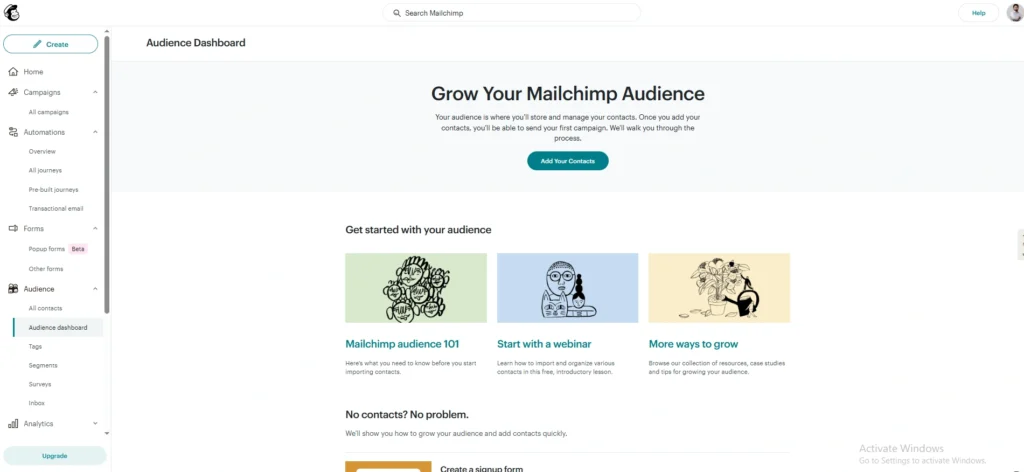
Additionally, Mailchimp’s segments are not updated in real time. You need to update the segments manually using the campaign builder or the segments page. This can seem outdated in today’s automated world.
Yet, there are still some positive aspects. Mailchimp provides pre-built segments that are easy to customize. This is a great way to launch a targeted email campaign in a short time.
Another advantage of Mailchimp is that it can create segments using up to 5 conditions. This lets you target very specific customer groups. This targeted segmentation improves deliverability and keeps emails out of spam folders. It also keeps you within your sending limit by avoiding less interested subscribers.
Shopify Email lets you create segments, but it’s not as easy. Shopify Email lacks direct segmentation features like Mailchimp. For creating segments, go to the “Customers” section in your Shopify dashboard. Then, go to Shopify Email to create your targeted email. This roundabout navigation can slow down your workflow.
Yet, Shopify offers segmentation templates. These include helpful pre-made groups, such as first-time buyers of certain products. These templates may not be as smooth as Mailchimp, but they still aid in basic segmentation.
6. Advanced Email Marketing Features
As your e-commerce marketing strategy expands, you might need more than email tools. You may need to send SMS, run social media ads, or create landing pages for specific promotions.
Both Shopify and Mailchimp offer these tools, but they take very different approaches.
Mailchimp provides many of these advanced features built into the platform. Shopify usually needs third-party apps, custom coding, or workarounds for similar features.
For example, A/B testing is not available in Shopify Email by default. Mailchimp simplifies A/B testing. It’s faster than installing an app or making two campaigns with random segments.
Mailchimp’s Standard Plan includes extra features that Shopify Email does not offer:
- Predictive analytics
- Comparative benchmark reporting
- Push notifications
- SMS campaigns
- Social media marketing tools
If you need these advanced tools, Mailchimp may be worth the cost. On Shopify, you would need to install paid apps for many of these features, and the costs can quickly add up.
7. User Experience
In this comparison of Shopify Email and Mailchimp, we’ll explore how each platform’s usability and features impact users’ experience.
Shopify Email Marketing Experience
Shopify Email is simple to use. It helps business owners set up and manage campaigns easily. Here’s how it simplifies email marketing:
- Seamless Integration: Shopify Email works smoothly with your Shopify store. This means you don’t have to set it up manually.
- User-Friendly Features: Anyone with little or no technical skills can navigate this platform easily. It offers pre-made templates, email scheduling, email testing, and clear analytics.
- Automated Email Sequences: Shopify Email lets you create automated workflows. You can set up welcome emails and reminders for abandoned carts. This helps keep your customers engaged with little effort.
Mailchimp offers advanced features for businesses. It supports advanced marketing needs through:
- Smart Segmentation: Businesses can segment their audience by location, buying history, and how they engage. This helps them create more targeted campaigns.
- Effective Automation: Mailchimp’s trigger-based workflows automatically send personalised emails. This ensures timely and relevant communication, which boosts customer engagement.
- In-Depth Analytics: Users can track detailed performance metrics. They can also see audience insights and comparative reports. This helps in optimising campaigns.
8. Analytics and Reporting
Analytics
Now, we’ll look at how each tool shows analytics. We’ll break it into 3 sections for a better comparison.
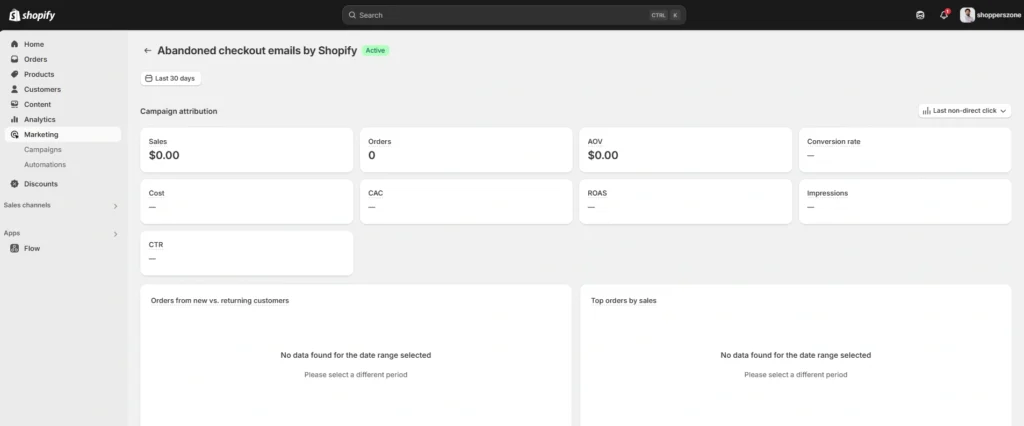
1. Basic Analytics
Both Shopify Email and Mailchimp provide essential email campaign metrics such as:
These standard analytics are essential for seeing how well your campaigns perform and understanding customer engagement.
2. Ecommerce-Specific Insights
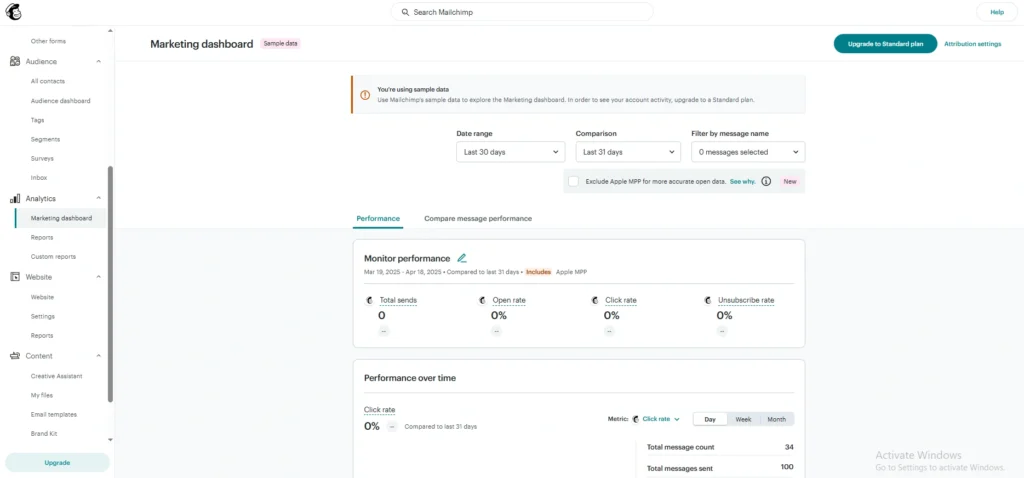
Shopify Email shines with its e-commerce insights. It provides clear metrics on sales and how customer shopping habits are shaped by your email campaigns. Some of these metrics include:
Additionally, Shopify Email tracks your customers’ marketing funnel behavior, such as:
- Unique visitors who visited your site after receiving the email
- Sessions where customers added products to their cart or made purchases
- Product page views and clicks on email links directing to your online store
These insights are crucial for e-commerce stores. They show how email performance ties directly to sales and customer interactions.
3. Advanced Analytics and Integrations
Shopify Email mainly tracks ecommerce metrics. In contrast, Mailchimp offers more analytics. It provides deeper insights into customer behaviour across various channels. Some of its key features include:
- Customer insights: Monitor customer behaviours, group them by buying chances, and spot high-value customers.
- Social media engagement: Measure how your campaigns are performing on social media channels.
- Landing page engagement: Check how well your landing pages convert and bring in leads.
Mailchimp’s ecommerce insights might not match Shopify’s in detail. It has one big advantage: over 300 integrations with third-party tools that Shopify Email doesn’t have. This includes linking with Google Analytics and other web analytics tools. This lets you enhance your email marketing using outside data. If you want to understand customer behaviour, social media, and third-party data, Mailchimp is a better choice.
Reporting
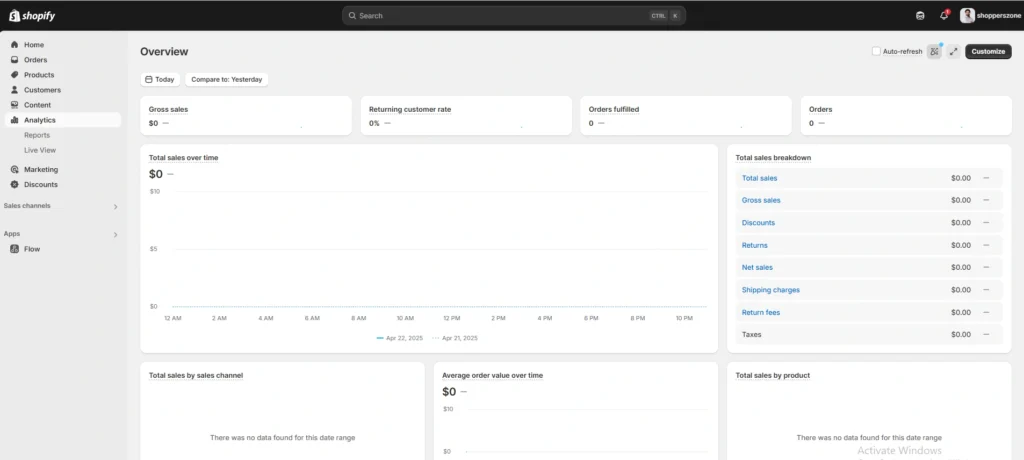
Shopify Email provides detailed reports on email campaign performance. However, it does not offer comparative benchmarking features. You can track metrics like open rates, click rates, and sales. You can’t compare these results with past campaigns or other segments to see which performs better.
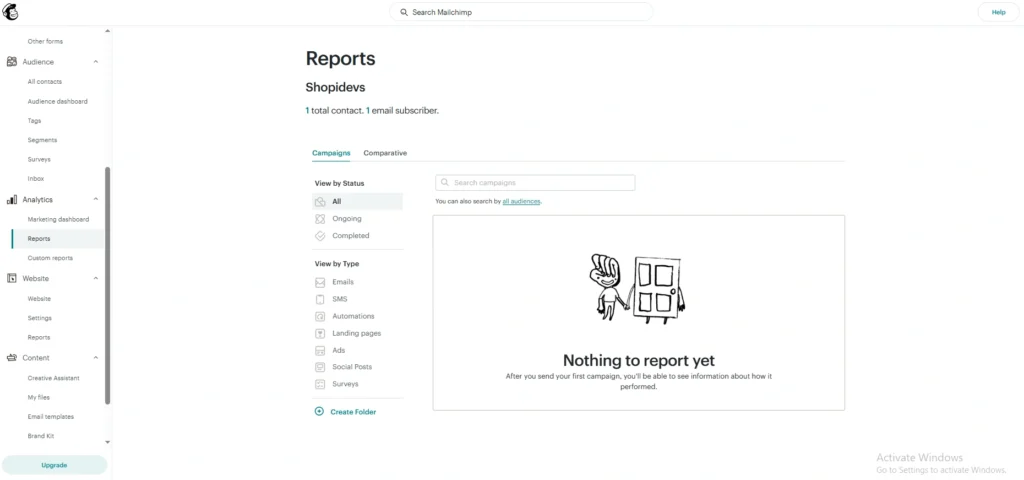
But Mailchimp excels in this area. It gives you reports to compare how various customer segments are doing.
A/B Testing
Another clear win for Mailchimp in this comparison is its A/B testing feature. Mailchimp lets you send different email versions to various customer groups. You can track which parts, like subject lines, images, or calls to action, work best. Optimising your emails with real data boosts conversions and engagement over time.
Also, Mailchimp offers send-time optimization. This means your emails go out when subscribers are most likely to open and engage with them. This feature provides an extra layer of precision to maximize email performance.
9. Pricing
Comparison of the Pricing between Shopify Email Marketing and Mailchimp:
| Feature | Shopify Email Marketing | Mailchimp |
| Free Plan | ✓ Yes – Includes 10,000 emails per month | ✓ Yes – Includes 500 contacts and 1,000 monthly emails |
| Cost After Free Limit | – $1 per 1,000 emails (up to 300,000)– $0.65 per 1,000 (300,001–750,000)– $0.55 per 1,000 (750,001+) | – Pricing increases based on contact list size and features |
| Essentials Plan | N/A – No tiered plans; pricing is volume-based | Starts at $13/month (for 500 contacts), includes basic automation and email templates |
| Standard Plan | N/A | Starts at $20/month (for 500 contacts), includes full automation, customer journeys, and analytics |
| Premium Plan | N/A | Starts at $350/month (for 10,000 contacts), includes advanced segmentation, multivariate testing |
| Included in Shopify Plans? | Yes – Integrated into Shopify admin; available with any paid Shopify plan | No – Must subscribe to Mailchimp separately |
| Automation Access | Free (via Shopify Flow on paid Shopify plans) | Limited to paid plans only |
10. User Review
User feedback is key in assessing email marketing tools. It provides insights into the strengths and weaknesses of each tool. Here’s a look at user reviews from reliable sites like G2, Trustpilot, and Capterra for Shopify Email and Mailchimp.
Shopify Email Marketing: User Appreciations & Criticisms
👍 Common Appreciations
Shopify Email stands out for its ease of use. It’s ideal for small businesses and newcomers looking for an easy email marketing tool.
Highlights from Reviews:
- Ease of Use: 80% of Trustpilot users say Shopify Email is easy to use. It’s great for people with little tech experience.
- Seamless Integration: Users like the simple setup. You don’t need extra setups, and the automatic integration with Shopify stores is a big plus.
- Affordable Pricing: Many customers appreciate the free plan. It allows up to 10,000 emails each month. This makes it a great option for budget-conscious startups.
👎 Common Criticisms
- User Friendly: Shopify Email is user-friendly. But, its automation and segmentation features are quite basic. This might not meet the needs of larger businesses.
- Scaling Challenges: Some users enjoy it for simple campaigns. But they struggle with more complex tasks as their business grows.
Mailchimp: User Appreciations & Criticisms
👍 Common Appreciations
Mailchimp has excellent features, but it can confuse beginners in email marketing.
Highlights from Reviews:
- Feature-Rich: Many users point out Mailchimp’s strong automation, segmentation, and analytics tools. This makes it ideal for businesses wanting advanced features.
- Customizable Templates: Users enjoy Mailchimp for its ability to create unique email designs. It offers lots of options to match their brand needs.
- Scalability: Many reviews say that Mailchimp helps businesses boost their marketing as they expand. It offers powerful features to help with this.
👎 Common Criticisms
- Steep Learning Curve: Many users, especially beginners, feel overwhelmed by Mailchimp’s feature-rich interface.
- Customer Support Issues: 90% of Trustpilot users report delays and uneven service when they ask for help, which is a concern.
Final Verdict
Shopify Email Marketing vs Mailchimp is a close comparison, but the best choice depends on your business needs.
If you want a simple, cost-effective, and fully integrated solution for your Shopify store, Shopify Email is a great pick. For those needing advanced automation, segmentation, and multichannel campaigns, Mailchimp offers more flexibility and power.
So, choose the platform that aligns with your marketing goals, technical skills, and budget for the best results.
FAQs
What are the best alternatives to Shopify Email and Mailchimp?
If you’re looking for other email marketing tools, some top alternatives include:
✔️ Klaviyo – Known for powerful ecommerce automation and segmentation
✔️ Omnisend – Great for multichannel marketing (email, SMS, push)
✔️ ConvertKit – Ideal for creators and digital products
✔️ Sendinblue (Brevo) – Good for transactional emails and budget-friendly campaigns
✔️ GetResponse – Offers advanced automation and landing page tools
Can I use Shopify Email and Mailchimp together?
Yes, you can use both at the same time. Shopify Email can be used for basic campaigns, while Mailchimp can handle more advanced automation or segmentation. However, manage your contacts carefully to avoid sending duplicate emails or overloading your subscribers.
Is It Possible to Switch between Shopify Email and Mailchimp?
Yes, switching is possible in either direction.
⭕️ From Shopify Email to Mailchimp: You can export your customer list from Shopify and import it into Mailchimp.
⭕️ From Mailchimp to Shopify Email: You can download your contact list from Mailchimp and upload it to your Shopify customer database.
🛑 Just follow email compliance rules (like getting consent) during the migration.
Does Mailchimp Integrate with Shopify?
Yes, Mailchimp now integrates directly with Shopify. You can sync your products, customers, and order data with Mailchimp to run ecommerce-focused email campaigns, automation, and product recommendations.
I am an SEO-friendly content and copywriter with 7 years of experience. I am confident in making and managing valuable digital content. My experience also includes executing successful SEO projects, managing teams, and staying up-to-date with the latest digital marketing trends and SEO updates.
